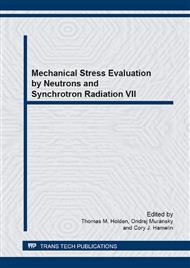p.1
p.7
p.12
p.19
p.25
p.31
p.35
p.40
p.46
Quantification and Prediction of Residual Stresses in Creep Crack Growth Specimens
Abstract:
An important issue to be considered in the life assessment of power plant components is the effects of prior creep damage on subsequent fatigue crack growth and fracture behavior. To examine these effects, creep damage has been introduced into 316H stainless steel material by interrupting creep crack growth (CCG) tests on compact tension, C(T), specimens at 550 °C. During the CCG tests, the specimen is loaded in tension, crept and unloaded after a small amount of crack extension. This process introduces compressive residual stress fields at the crack tip, which may subsequently affect the fatigue crack growth test results. In this work, neutron diffraction (ND) measurements have been conducted on interrupted CCG test specimens, which contain creep damage local to the crack tip, and the results are compared to predictions obtained from finite element (FE) simulations. Reasonable agreement has been found between the FE predictions and ND measurements.
Info:
Periodical:
Pages:
25-30
Citation:
Online since:
February 2014
Authors:
Keywords:
Price:
Сopyright:
© 2014 Trans Tech Publications Ltd. All Rights Reserved
Share:
Citation:


